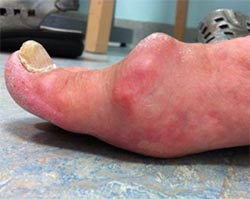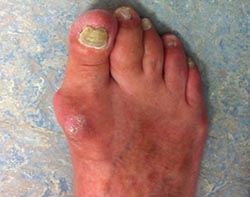What is Hallux Rigidus?
Hallux rigidus is quite literally stiff (rigidus) big toe (hallux).
Why does it develop?
The most common cause for a stiff big toe is arthritis. Arthritis may develop following an injury, there are a number of other theories as to why it develops, but the cause is unknown in most people.
What symptoms does it cause?
Pain: Sometimes this pain only occurs towards the end of the range of upward movement of the toe, but as the arthritis becomes more severe the pain occurs with any movement.
Stiffness: As the title suggests its development leads to stiffening of the big toe.
 Bony prominences: As the arthritis develops extra bone usually forms at the edges of the joint, this may be prominent and rub on shoes (see photos below for a very advanced example).
Bony prominences: As the arthritis develops extra bone usually forms at the edges of the joint, this may be prominent and rub on shoes (see photos below for a very advanced example).
What options are there for treatment?
a. Shoes
If it is just the prominent bone that is a problem, then shoes with soft uppers may help. If the pain is worse with movement then stiff soled shoes especially if they have a camber to the sole may help (a curve when viewed from the side). There are a number of such shoes that are commercially available.
 b. Pain relieving medication
b. Pain relieving medication
Pain killers or anti inflammatory tablets may be sufficient to keep the pain under control.
There is no significant evidence at present to suggest that the use of orthotics is beneficial in children with asymptomatic flexible flat feet.
c. Injections
These may help, however the period of relief following injection varies and is usually only beneficial in the early stages.
d. Surgery
This is generally of two types:
1. Cheilectomy (See: Hallux Rigidus 1: Cheilectomy).
This is useful if the pain only occurs when the toe bends upwards or if the pain is due to the prominent area of bone on the top of the joint rubbing on shoes.
2. Fusion (See: Hallux Rigidus 2: Fusion)
Note: Joint replacements have been fashionable in the past, however the joint at the base of the big toe is surprisingly complex and as a result these replacements tend to fail. At present evidence in the literature is not sufficient for these to be recommended, this may change in the future.
Occasionally an interposition arthroplasty may be considered, for more information about this please ask your specialist.
